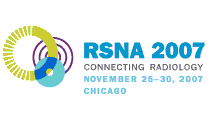
Abstract Archives of the RSNA, 2007
SSC20-04
Utility of Contrast-enhanced Cardiac MRI as a Noninvasive Alternative to Transesophageal Echocardiography for Diagnosis of a Cardiac Etiology of Stroke/TIA
Scientific Papers
Presented on November 26, 2007
Presented as part of SSC20: Cardiac (MR)
William Brian Hyslop MD, PhD, Presenter: Nothing to Disclose
James Barnwell BS, Abstract Co-Author: Nothing to Disclose
Jennifer W. Simmons, Abstract Co-Author: Nothing to Disclose
Souvik Sen MD, Abstract Co-Author: Nothing to Disclose
Transesophageal echocardiography (TEE) is an invasive procedure used to detect cardiac etiologies of embolic stroke or TIA. Contrast-enhanced MRI was compared to TEE for the detection of atherosclerotic disease of the thoracic aorta, cardiac thrombi, patent foramen ovale (PFO), and atrial septal aneurysm (ASA).
Twenty adult patients (ages 39-87 y, median of 70 y) with a diagnosis of stroke/TIA and a TEE within the previous six months were prospectively enrolled to have a cardiac MRI on a 1.5 T magnet. The protocol included an axial non-breathhold EKG-gated dual-echo spin echo MRI of the thoracic aorta (TR/TE1/TE2=900/29/69), true FISP cine imaging through the atrial septum (flip/TR/TE=60/38/1.7), axial 2D true FISP imaging of the thorax (65/38.4/1.48),immediate post-contrast imaging through the atrial septum using a dynamic saturation-recovery pulse sequence(12/180/1.18)with 4 slices/heartbeat, and a 3D gradient-echo image of the thorax (12/4.0/1.71). Atherosclerotic plaque in the aorta was assessed using spin-echo and 3D images. Ballooning of the atrial septum during cine imaging was used to assess for ASA. PFO was diagnosed either by a turbulent jet on cine imaging, or qualitative assessment of early enhancement of the left atrium. Intracardiac filling defects on true FISP, cine, or 3D imaging were used to detect cardiac thrombi. Results were compared to TEE findings.
Atherosclerotic disease in the arch and/or descending thoracic aorta was present in 19 of 20 patients on both modalities. Plaque in the ascending aorta of ten patients was only detected on MRI. No cardiac thrombi were detected by either modality. Eight of twenty patients had an ASA on both studies. MRI had a 22% sensitivity (2/9) for the detection of PFO. Eleven patients were negative for PFO on both TEE and MRI.
Although there was good agreement between TEE and MRI for the detection of atherosclerotic aortic disease, ASA, and exclusion of cardiac thrombi, MRI had limited sensitivity for the detection of PFO.
Although MRI is an excellent non-invasive alternative to TEE for the detection of atherosclerotic disease and exclusion of cardiac thrombi, it has limited sensitivity for the detection of PFO.
Hyslop, W,
Barnwell, J,
Simmons, J,
Sen, S,
Utility of Contrast-enhanced Cardiac MRI as a Noninvasive Alternative to Transesophageal Echocardiography for Diagnosis of a Cardiac Etiology of Stroke/TIA. Radiological Society of North America 2007 Scientific Assembly and Annual Meeting, November 25 - November 30, 2007 ,Chicago IL.
http://archive.rsna.org/2007/5007986.html

